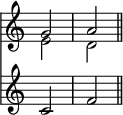A Dictionary of Music and Musicians/Hidden Fifths and Octaves
HIDDEN FIFTHS AND OCTAVES (Lat. Quintæ coopertæ, sen absconditæ; Germ. Verdeckte Quinten). Hidden Fifths, or Octaves, are held to be produced, whenever two parts proceed, in similar motion, towards a single Fifth, or Octave, to which one of them at least progresses by a leap, as in the following example:

Progressions such as these are prohibited, because, were the leaps filled up by the intervals of the Diatonic Scale, the hidden 'consecutives' [see Consecutive] would at once be converted into real ones, thus:
A musical score should appear at this position in the text. See Help:Sheet music for formatting instructions |
It may be urged, that, as the leaps are not intended to be filled up, the forbidden sequence is not formed, and there remains, therefore, nothing to be condemned.
The answer to this objection is twofold. In the first place, the impression left on the ear by Hidden Fifths or Octaves is sometimes almost as strongly marked as that produced by real ones; the ear itself possessing the faculty of filling up the leaps, in imagination, when tempted to do so by the nature of the progression submitted to it. Secondly, in unaccompanied vocal music to which the prohibition most particularly refers the least tendency on the part of an incautious singer to bridge over the leap by means of a portamento would instantly produce the effect indicated in the above example.
Nevertheless, the law against Hidden Fifths and Octaves is not an inelastic one. It is true, that, in two-part counterpoint, they are as sternly condemned as the most glaring sequence of real Fifths. Even in three parts their presence is scarcely tolerated. But, in four or more parts, they are only to be reprehended under certain conditions. For instance, between the extreme parts they should only be used as a means of escape from some serious difficulty. Between one extreme and one mean part they are considered less objectionable. Between two mean parts there is little to be said against them; and, when one of the parts concerned in their formation moves a semitone, they are freely permitted, even between treble and bass. Bearing these rules in mind, the student can scarcely go very far wrong; and, should he find any difficulty in detecting the faulty progressions, it may be removed by a reference to the old law, which enacts that 'A Perfect Concord may not be approached in similar motion.'
The great masters of the 16th century were far more lenient towards Hidden Fifths and Octaves than many modern theorists. In the works of Palestrina and his contemporaries, examples, even between extreme parts, may be found on almost every page.[1] These composers also delighted in hiding Fifths and Octaves in another and a singularly beautiful way. It is of course understood that such progressions are only forbidden when they occur between the same two parts. When formed between different voices, by means of crossing the parts, they are perfectly lawful; as in the following combinations from Palestrina's 'Missa Papae Marcelli' and 'Missa Brevis':
 |
 |
The effect of such passages as these, when sung without accompaniment, is perfectly pure and beautiful; but when arranged for keyed instruments, where the motion of the parts cannot be distinguished, they become simply intolerable.
 |
 |
- ↑ In the beginning of Palestrina's motet 'Fratres ego' there is indeed an instance of Hidden Fifths, In two parts; but this case is so extraordinary that the writer cannot remember ever having met with a parallel one.